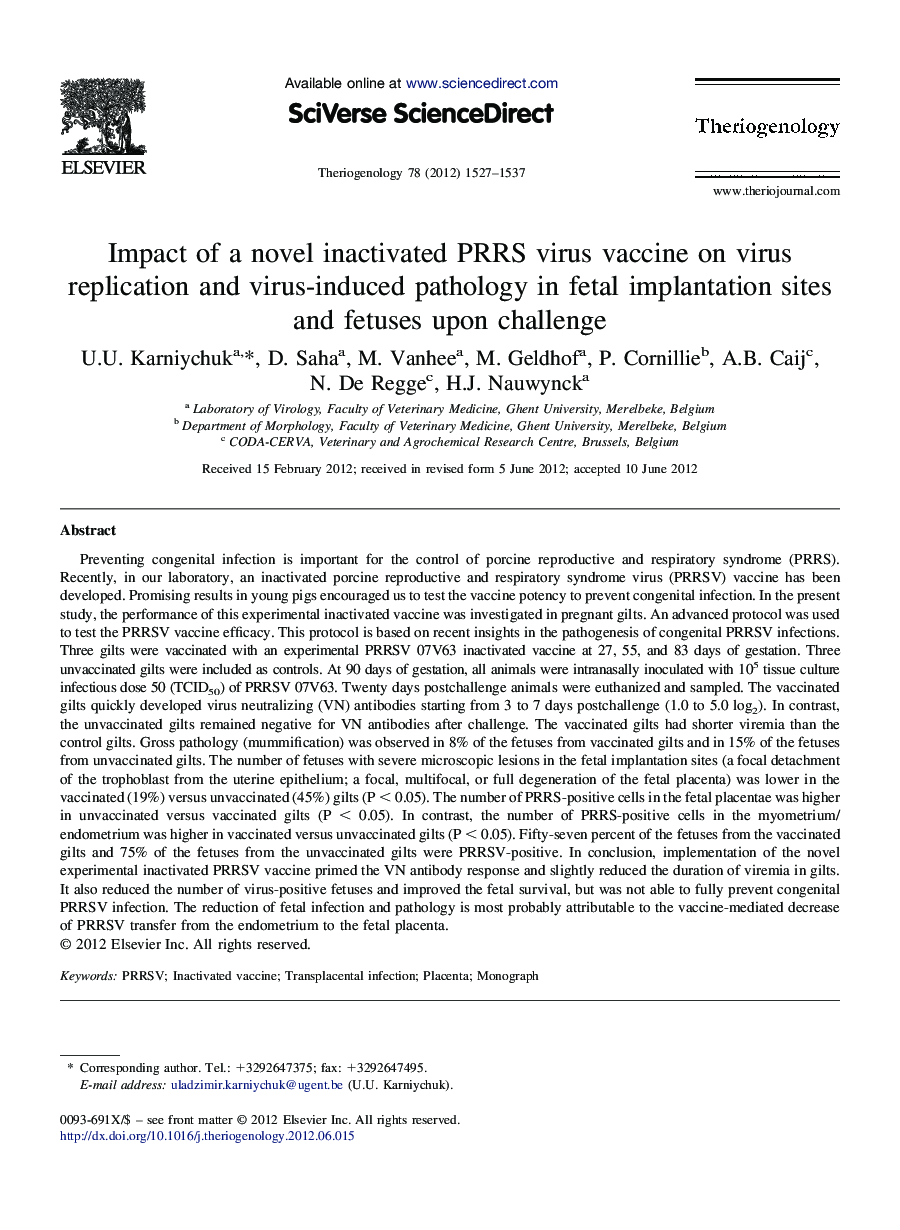| Article ID | Journal | Published Year | Pages | File Type |
|---|---|---|---|---|
| 10892639 | Theriogenology | 2012 | 11 Pages |
Abstract
Preventing congenital infection is important for the control of porcine reproductive and respiratory syndrome (PRRS). Recently, in our laboratory, an inactivated porcine reproductive and respiratory syndrome virus (PRRSV) vaccine has been developed. Promising results in young pigs encouraged us to test the vaccine potency to prevent congenital infection. In the present study, the performance of this experimental inactivated vaccine was investigated in pregnant gilts. An advanced protocol was used to test the PRRSV vaccine efficacy. This protocol is based on recent insights in the pathogenesis of congenital PRRSV infections. Three gilts were vaccinated with an experimental PRRSV 07V63 inactivated vaccine at 27, 55, and 83 days of gestation. Three unvaccinated gilts were included as controls. At 90 days of gestation, all animals were intranasally inoculated with 105 tissue culture infectious dose 50 (TCID50) of PRRSV 07V63. Twenty days postchallenge animals were euthanized and sampled. The vaccinated gilts quickly developed virus neutralizing (VN) antibodies starting from 3 to 7 days postchallenge (1.0 to 5.0 log2). In contrast, the unvaccinated gilts remained negative for VN antibodies after challenge. The vaccinated gilts had shorter viremia than the control gilts. Gross pathology (mummification) was observed in 8% of the fetuses from vaccinated gilts and in 15% of the fetuses from unvaccinated gilts. The number of fetuses with severe microscopic lesions in the fetal implantation sites (a focal detachment of the trophoblast from the uterine epithelium; a focal, multifocal, or full degeneration of the fetal placenta) was lower in the vaccinated (19%) versus unvaccinated (45%) gilts (P < 0.05). The number of PRRS-positive cells in the fetal placentae was higher in unvaccinated versus vaccinated gilts (P < 0.05). In contrast, the number of PRRS-positive cells in the myometrium/endometrium was higher in vaccinated versus unvaccinated gilts (P < 0.05). Fifty-seven percent of the fetuses from the vaccinated gilts and 75% of the fetuses from the unvaccinated gilts were PRRSV-positive. In conclusion, implementation of the novel experimental inactivated PRRSV vaccine primed the VN antibody response and slightly reduced the duration of viremia in gilts. It also reduced the number of virus-positive fetuses and improved the fetal survival, but was not able to fully prevent congenital PRRSV infection. The reduction of fetal infection and pathology is most probably attributable to the vaccine-mediated decrease of PRRSV transfer from the endometrium to the fetal placenta.
Related Topics
Life Sciences
Agricultural and Biological Sciences
Animal Science and Zoology
Authors
U.U. Karniychuk, D. Saha, M. Vanhee, M. Geldhof, P. Cornillie, A.B. Caij, N. De Regge, H.J. Nauwynck,
